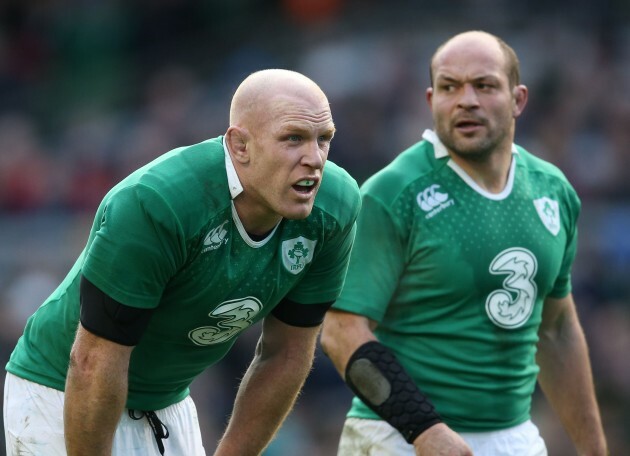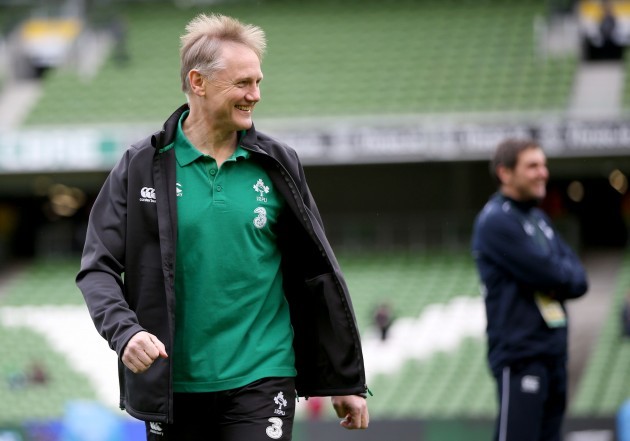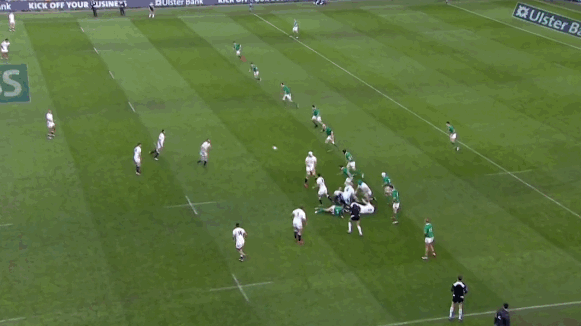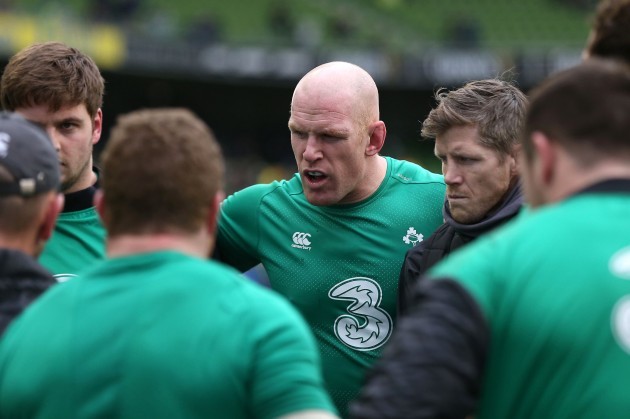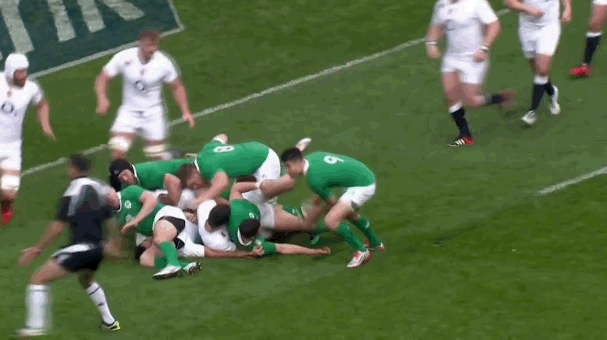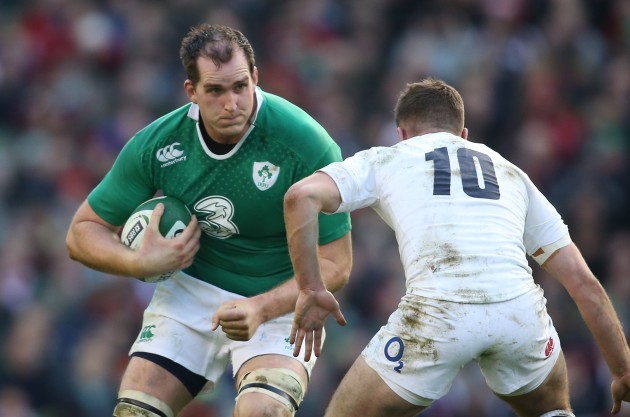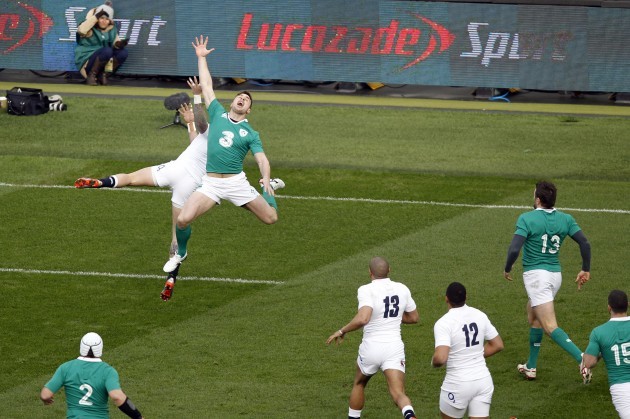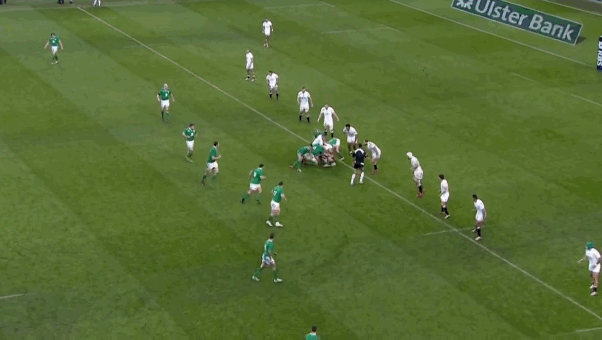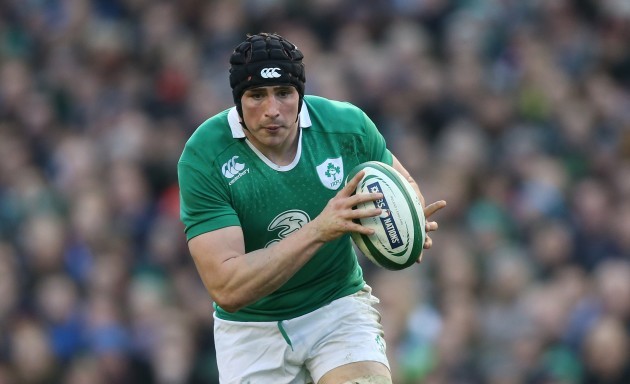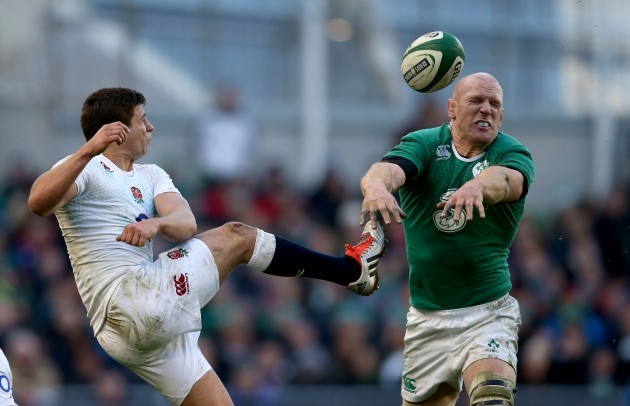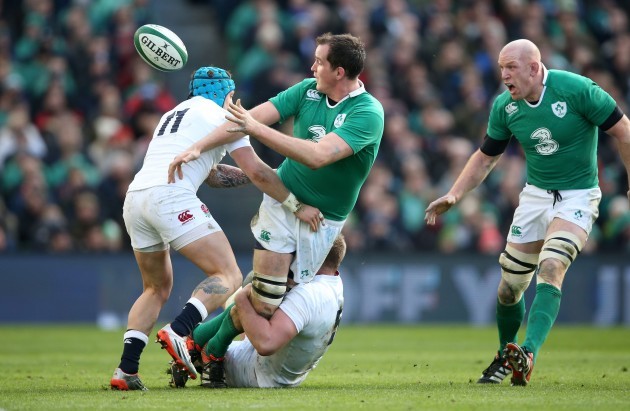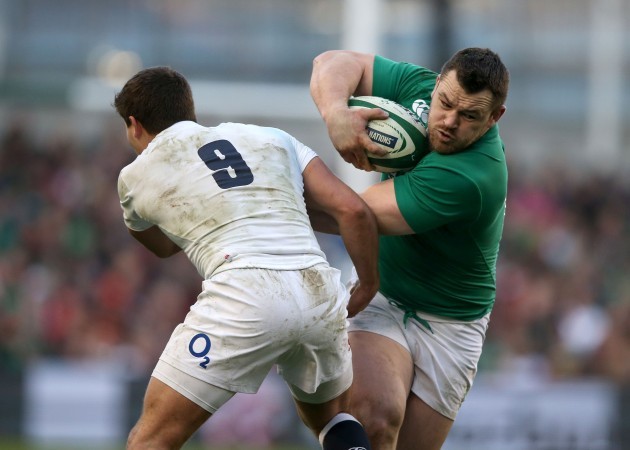IRELAND RETURN TO camp in Belfast today to review their win over England and begin preparations for taking on Wales on 14 March in Cardiff.
As part of our own review here at The42, we’ve been examining the rucking efforts of Ireland during Sunday’s victory over the English, as we did after the Italy win.
To our regret, we didn’t find the time to carry out this exercise following the fixture against France, but it is our intention to do so before the tournament is finished. Having a complete set of data around Ireland’s ruck involvements for the entire 2015 Six Nations would obviously be very useful.
For those who haven’t seen an article like this before on The42, it’s worth going back to the piece on Ireland’s rucking against Italy and reading the section entitled ‘What we’re looking at’.
There you will find an explanation of the various ruck actions we’ve accounted for again below.
Ruck masters
Joe Schmidt’s Ireland are one of the most effective rucking teams in the world, rivalling even the mighty New Zealand in this aspect of the game.
Defensively, they compete ferociously to steal or slow opposition possession, while their attacking rucking is generally swift and effective. It makes sense to dedicate much of Ireland’s preparation and training to the breakdown and ruck, given that there are so many of them in every single match.
Prozone Sports released data after the England win that revealed Ireland’s average ruck speed when attacking on Sunday was 3.02 seconds. Across 2014, Ireland averaged 2.83 seconds recycling time per ruck, again according to Prozone.
Ruck speed isn’t everything, but it is a good indicator of success, particularly as quicker ruck ball heavily favours the attacking team. In that regard, it was another good outing for Schmidt’s side on Sunday, although there’s always room for improvement.
One of the most interesting factors in Ireland’s rucking is that they will generally add extra bodies to the ruck to make absolutely sure that they retain possession. Prozone tell us that Ireland averaged 3.3 players in each ruck against England.
That much was hammered home by our own analysis of last weekend’s game, with lots of third and fourth-man arrivals for Schmidt’s side. They prioritise retaining the ball post-tackle, even if there is never any willingness to accommodate ‘ruck inspectors’.
England therefore struggled to win turnovers at the breakdown, something Ireland certainly did manage when Stuart Lancaster’s side attacked.
Perhaps one of the worries for Schmidt’s team in recent times has been an ability to consistently break down the opposition defence with ball in hand. They’re scoring tries, but they often find it difficult to work their way through the opposition defence by running the ball.
Again referring to Prozone’s stats, Ireland made gainline successes on only 49% of their 135 carries, a stark contrast to England’s 72.6%.
Winning the gainline makes the subsequent ruck a whole lot easier, so that makes Ireland’s effective rucking against England all the more impressive. Oftentimes the rucking players weren’t afforded momentum to arrive into the ruck with, meaning their technique and aggression levels had to be very high.
Overall, Ireland lost just two of their 118 rucks, whereas England lost seven of their 85. Below, we detail exactly what each of the Irish players did to contribute to another excellent rucking performance.
Murphy’s masterclass
It’s often pointed out that Jamie Heaslip does the ‘unseen work’ for Ireland, something that certainly holds up when one studies his involvements for Joe Schmidt’s side and narrows in on the finer details of the game such as rucking and the set-piece.
Asked to replace Heaslip at number eight in this game, Jordi Murphy got through a mountain of the unseen stuff, including 50 ruck involvements on both sides of the ball.
Nine of those were when Ireland were defending, and the 23-year-old also did a superb job of disrupting English possession. As well as two turnovers, Murphy assisted two further turnovers, slowed the ball twice and was also present on three occasions.
When Ireland had the ball, Murphy was equally impactful as he racked up 16 effective involvements at attacking rucks.
He was first man in on 10 occasions, but 16 third arrivals points to the fact that his role was not always about being the first guy on the scene. The number eight’s positioning often means he’s second or third in, and he guarded the ball well.
Ireland remain hopeful that Heaslip will be fit to face Wales, but Murphy has justified the backing of Schmidt against Italy and England. Last weekend, he also made 11 strong tackles and chipped in with a handful of carries, as well as three line-out takes.
A workaholic performance from the Leinster back row.
Paulie as busy as ever
You probably don’t need rucking stats to underline that Paul O’Connell is a busy man around the pitch for Ireland, but once again the numbers back up that impression.
Ireland’s captain was involved in the rucks 44 times against England, including two dominant clear-outs with his side on the attack. Remarkably, O’Connell was first arrival on 14 occasions, as well as being second in no less than 16 times.
Overall, it was another effective rucking performance from the 35-year-old, who maintains the ability to summon the aggression and technique needed to clear bodies even when under intense fatigue.
Defensively, we’ve come to expect the sight of the Munster lock powering into the opposition rucks and that was the case against the English. Two turnover assists were excellent, while he also slowed the ball twice and was present four other times.
The key ruck leader for Schmidt’s side.
O’Mahony at the coalface
In what was by some distance his finest game of the championship so far, Peter O’Mahony was sublime around the rucks for Ireland in his 38 total involvements, adding notable quality to the numbers.
Two dominant smashes of Englishmen were matched by 12 effective contributions in clearing-out, while O’Mahony was also dogged in defence too, winning two turnovers and slowing the ball a team-leading four times.
He did concede one penalty at the breakdown, referee Craig Joubert pinging him for supporting his body weight with his elbows as he jackaled, but this showing underlined O’Mahony’s status as a crucial player for Ireland.
On top of the 29 Ireland rucks in which he was one of the first three men in, O’Mahony was superb around the lineout, stealing one English throw, claiming two of Ireland’s and lifting well too.
With ball in hand, there wasn’t too much gainline progress in tight channels, but there were four good passes, and it’s exciting to see Schmidt use O’Mahony in that role. A very rounded display as the Munster captain epitomised Ireland’s work rate.
Seamless transition
Much has been made of the ability of Schmidt’s squad to seamlessly cover for injuries to the ‘big names,’ including Sean O’Brien. In that regard, we got a microcosm of the issue when Tommy O’Donnell replaced the concussed openside flanker on Sunday.
Before his injury, O’Brien was hugely effective at the rucks, notching 18 involvements in just 24 minutes of play, which included one dominant hit and six effective clear-outs. Defensively, he managed to slow the English ball twice.
O’Donnell was sent in to replace O’Brien thereafter, and as against Italy, there was no noticeable difference for Ireland. The Munster openside had 24 total involvements, five of which involved disrupting English ball.
One noticeable aspect of O’Donnell’s rucking is that he works so hard to be first man in during open play. From set-piece, we expect the openside to often be first on the scene post-tackle, but even in phase play the Tipp native busts a gut to get in early and effectively.
Two dominant actions and 10 effective involvements as Ireland attacked signify as much, with O’Donnell first man in on 10 occasions. As with Murphy replacing Heaslip, Schmidt can remain confident that he has another openside constantly ready and waiting.
Bits and pieces
The rest of the pack contributed well to Ireland’s rucking cause, Devin Toner in particular standing out. His involvements at ruck time totalled 36, another big shift from a man who has worked hard to be more effective in this aspect of the game.
Most notable were Toner’s actions as second arrival, when he had three dominant clear-outs and nine further effective markings. Adding the ruck efforts to a pair of brilliant lineout steals and a handful of carries, the 28-year-old again underlined his importance as a starting lock.
Jack McGrath was not far behind with his 29 ruck involvements, just a single ineffective contribution among them.
Cian Healy impressed off the bench late in the game, but McGrath’s scrum solidity, technical ruck excellent and high work rate mean he has a strong chance of retaining the number one shirt for Cardiff.
Similarly, Mike Ross has done more than enough to remain as Ireland’s first-choice tighthead against Wales after another impressively solid outing. He beat Joe Marler at scrum time, added a cluster of carries [three] and tackles [five], and also got around the rucks.
Ross was involved in 28 of Ireland’s attacking rucks, without a single ineffective contribution. Lots of his work is arriving as third man to play guard and just add that element of security, but his first arrivals were very effective.
Finally, Rory Best had a total of 21 involvements, probably not as high as we’ve come to expect from the hooker. That said, the Ulsterman’s was very much a case of quality over quantity.
Defensively, Best was particularly effective, securing one turnover and slowing the ball on another occasion, while his eight first arrivals on Ireland attack were extremely impressive. The 32-year-old is a wily operator post-tackle, which was underlined here.
Bowe the busiest back
One of the notable features of Schmidt’s wings are the demands on them to be involved in the rucks. Andrew Trimble and Dave Kearney stood out in this regard during last season’s Six Nations triumph, but Tommy Bowe and Simon Zebo have taken over the rucking mantle with some confidence.
Bowe had the most involvements of any Irish back against England with 21, although nine of those were as a guard over the ball. Still, there was real impact in Bowe’s rucking too, particularly as second man when he had five effective marks.
Zebo, meanwhile, threw himself into rucks with eagerness – most notably in the build-up to Robbie Henshaw’s try – and racked up 17 total involvements. One dominant hit and eight effective clear-outs signified the Munster wing’s ever-growing rucking competence and work rate.
Elsewhere, fullback Rob Kearney had a notably effective afternoon at ruck time. Like Schmidt’s wings, his fullback must be highly efficient in this area of the game; it’s a 15-man imposition on Ireland’s players.
All but two of Kearney’s 14 total impacts had a telling impact, and there was real aggression and precision in the Leinster man’s general play. He made some superb hits on the outside edge of the Ireland defence, and rucking-wise had one dominant and nine other effective actions.
Ireland’s halfbacks were understandably not called on too often to ruck, but when they were, Johnny Sexton and Conor Murray got the job done. Neither halfback is a small man, and their relative size and appetite for physical contact aids them at the ruck.
Every one of Murray and Sexton’s eight total involvements as a pairing was effective against the English.
Finally, Ireland’s centre duo were once again highly competent when it came to hitting rucks. It’s no surprise really, given how hard Schmidt drills the importance of retaining the ball at rucks into his players.
Jared Payne and Robbie Henshaw had 15 rucking involvements each, with the Ulsterman’s seven first arrivals standing out as particularly important [five of them were effective].
Henshaw had a dominant marking as first man in on one occasion, showing that his power can be utilised at ruck time too. Ireland’s centres have partly been picked for their size and physical abilities, something that’s certainly useful post-tackle.
Moore adds more
Part of Schmidt’s coaching philosophy is that the bench players [and other squad members] are just as important as his starting XV, something that applies as much to rucking as other parts of the game.
In that sense, there are heavy demands on the Ireland replacements to make an impact on the rucks and that did occur again against the English.
Marty Moore stood out, notching 15 involvements that included a turnover, one slowing marking and seven strong second arrivals. While a scrum penalty concession will rankle, the tighthead continues to provide excellent competition for Ross.
Unsurprisingly, Cian Healy was highly evident at the rucks after replacing Jack McGrath at loosehead prop. Healy is a world-class player returning to match fitness after a long-term injury, meaning his 14 involvements were always likely be be strong.
At the defensive ruck, the prop was a nuisance to England, slowing the ball twice and being present four other times. On Ireland’s ball, Healy was similarly impressive, racking up one dominant and four effective contributions in clearing bodies out of the way for scrum-half Murray.
Elsewhere, Iain Henderson added his usual enthusiasm and raw power to the mix for Ireland, while Ian Madigan also chipped in with one slowing action and one present, as well as playing guard once.
Top of the Pops
Below, we’ve listed the rucking involvements for each Irish player in the starting team and those who came off the replacements bench.
First arrivals
14 Paul O’Connell – 2 dominant, 7 effective, 3 guard, 1 ineffective, 1 present
10 Tommy O’Donnell – 1 dominant, 6 effective, 3 guard
10 Jordi Murphy – 6 effective, 3 guard, 1 present
9 Peter O’Mahony – 1 dominant, 6 effective, 1 guard, 1 present
8 Rory Best – 1 dominant, 5 effective, 1 guard, 1 present
7 Jack McGrath – 5 effective, 1 guard, 1 ineffective
7 Jared Payne – 5 effective, 1 guard, 1 ineffective
7 Devin Toner – 4 effective, 1 present, 2 ineffective
6 Mike Ross – 6 effective
5 Sean O’Brien – 1 dominant, 3 effective, 1 guard
5 Simon Zebo – 3 effective, 2 guard
5 Tommy Bowe – 3 effective, 2 guard
4 Rob Kearney - 4 effective
4 Conor Murray – 4 effective
4 Cian Healy – 3 effective, 1 ineffective
3 Robbie Henshaw – 1 dominant, 2 effective
2 Johnny Sexton – 2 effective
2 Ian Madigan – 1 effective, 1 guard
2 Iain Henderson – 1 effective, 1 ineffective
1 Marty Moore, Felix Jones – both 1 effective
Second arrivals
16 Paul O’Connell – 9 effective, 5 guard, 2 ineffective
15 Devin Toner – 3 dominant, 9 effective, 1 guard, 1 present, 1 ineffective
10 Peter O’Mahony – 1 dominant, 4 effective, 3 guard, 2 present
10 Jordi Murphy – 6 effective, 2 guard, 1 present, 1 ineffective
9 Tommy Bowe – 5 effective, 4 guard
7 Rob Kearney – 1 dominant, 4 effective, 2 guard
7 Marty Moore – 3 effective, 4 guard
6 Jack McGrath – 1 dominant, 3 effective, 2 guard
6 Mike Ross – 4 effective, 1 guard, 1 present
5 Tommy O’Donnell – 4 effective, 1 guard
5 Simon Zebo – 1 dominant, 2 effective, 2 present
5 Rory Best – 1 effective, 3 guard, 1 present
4 Robbie Henshaw – 3 effective, 1 guard
2 Cian Healy – 1 dominant, 1 effective
2 Jared Payne – 2 effective
2 Sean O’Brien – 1 effective, 1 present
2 Iain Henderson – 2 guard
1 Johnny Sexton – 1 effective
Third arrivals
16 Jordi Murphy – 4 effective, 9 guard, 2 present, 1 ineffective
10 Devin Toner – 4 effective, 4 guard, 1 present, 1 ineffective
10 Peter O’Mahony – 2 effective, 7 guard, 1 present
8 Mike Ross – 1 effective, 6 guard, 1 present
7 Jack McGrath – 3 effective, 2 guard, 2 present
7 Sean O’Brien – 2 effective, 5 guard
5 Paul O’Connell – 1 effective, 4 guard
5 Simon Zebo – 3 effective, 2 guard, 1 ineffective
5 Robbie Henshaw – 1 effective, 3 guard, 1 present
5 Tommy Bowe – 5 guard
4 Rory Best – 2 effective, 2 guard
4 Marty Moore – 3 guard, 1 effective
3 Jared Payne – 1 effective, 2 guard
2 Tommy O’Donnell – 1 dominant, 1 guard
1 Rob Kearney – 1 effective
1 Johnny Sexton – 1 effective
1 Ian Madigan – 1 guard
Defensive efforts
9 Jordi Murphy – 2 turnovers, 2 turnover assists, 2 slowing, 3 present
8 Paul O’Connell – 2 turnover assists, 2 slowing, 4 present
8 Peter O’Mahony – 2 turnovers, 4 slowing, 1 present, 1 miss [conceded penalty]
6 Cian Healy – 2 slowing, 4 present
5 Tommy O’Donnell – 1 turnover assist, 2 slowing, 2 present
4 Rory Best – 1 turnover, 1 slowing, 2 present
4 Sean O’Brien – 2 slowing, 2 present
4 Jack McGrath – 1 slowing, 3 present
3 Marty Moore – 1 turnover, 1 slowing, 1 present
2 Robbie Henshaw – 1 turnover, 1 present
2 Jared Payne – 1 turnover assist, 1 slowing
2 Tommy Bowe – 1 turnover assist, 1 present
2 Rob Kearney - 1 turnover assist, 1 present
2 Devin Toner – 1 slowing, 1 present
2 Iain Henderson – 2 slowing
2 Ian Madigan – 1 slowing, 1 present
1 Simon Zebo – 1 turnover assist
1 Sean Cronin – 1 present
Rucking actions per minute of game time
0.75 Sean O’Brien
0.65 Marty Moore
0.64 Cian Healy
0.62 Jordi Murphy
0.55 Devin Toner
0.55 Paul O’Connell
0.50 Jack McGrath
0.49 Mike Ross
0.47 Peter O’Mahony
0.43 Tommy O’Donnell
0.40 Iain Henderson
0.29 Rory Best
0.26 Tommy Bowe
0.21 Simon Zebo
0.21 Jared Payne
0.21 Ian Madigan
0.19 Robbie Henshaw
0.17 Rob Kearney
0.14 Sean Cronin
0.10 Felix Jones
0.08 Johnny Sexton
0.05 Conor Murray
Analysis: How did Ireland dominate England in the Six Nations?
Analysis: What the hell was Sean O’Brien doing to the England maul?
